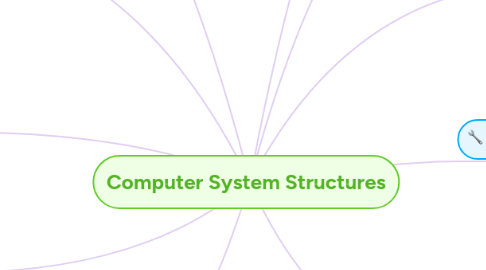
1. Computer- System Operation
1.1. General-purpose computer system consists of the one or more CPUs and a number of device controllers.
1.2. Each device controller is in charge of a specific type of device.
1.3. Each device controller has local buffer.
1.4. The CPU and device controller can execute concurrently.
1.5. Interrupt indicates the occurrence of an event from either the hardware or software.
2. Two I/O Methods
2.1. Synchronous I/O Structure
2.1.1. After I/O starts, control returns to user program only upon I/O completion.
2.2. Asynchronous I/O Structure
2.2.1. After I/O starts, control returns to user program without waiting for I/O completion.
3. Interrupt Handling
3.1. Separate segments of code determine what action should be taken for each type of interrupt
3.2. When the CPU is interrupted, it stops what it is doing and immediately transfers execution to a fixed location.
3.2.1. The fixed location contains the starting address of the interrupt service routine.
3.3. Interrupt vector provide the address of the interrupt service routine for the interrupting device.
3.4. After the is serviced, the saved return address is loaded into the program counter.
3.4.1. The interrupted computation resumes.
3.5. The OS preserves the state of the CPU by storing registers and the program counter.
4. Storage Structure
4.1. Volatile - A volatile storage device that loses its contents when power is turned off.
4.1.1. Register , Cache , Main memory and Electronic disk.
4.2. Non-volatile - It is capable to hold large quantities of data permanently.
4.2.1. Magnetic disk , Optical disk and Magnetic tapes
5. Storage Hierarchy
5.1. Storage system organized in hierarchy
5.1.1. speed, cost and voilatility.
5.2. Caching - copying information into faster storage system main memory can be viewed as a last cache for secondary storage.
6. Dual-Mode Operation
6.1. User mode
6.1.1. User program executes in user mode.
6.1.2. Certain areas of memory are protected from user access.
6.1.3. Certain instructions may not be executed.
6.2. Kernel mode
6.2.1. Monitor executes in kernel mode.
6.2.2. Privileged instructions may be executed.
6.2.3. protected areas of memory may be accessed.
7. I/O Protection
7.1. All I/O instructions are privileged instruction; user program cannot issue I/O instruction directly.
7.1.1. User program must executes a system call to request that the operating system to perform I/O.
7.2. Must ensure that a user program could never gain control of the computer in monitor mode.
7.2.1. A user program, as part of its execution, stores a new address in the interrupt vector.
8. Memory Protection
8.1. The computer system must provide memory protection at least for the interrupt vector and the interrupt service routines.
8.2. In order to have memory protection,two registers are used to determine the range of legal addresses a program may access.
8.2.1. Base register- holds the smallest legal physical memory address.
8.2.2. limit register- contains the size of the range.
8.3. Memory outside the defined range is protected.
9. Hardware Address Protection
9.1. When executing in kernel mode, the operating system has unrestricted access to both monitor and user's memory.
9.1.1. Operating system is allowed to load users' program into users' memory, to access and modify parameter of system calls.
9.2. The load instructions for the base and limit registers are privileged instructions.
10. CPU Protection
10.1. Timer- Interrupt computer after specified period to ensure operating system maintains control over CPU.
10.2. When timer interrupts,control transfers to the operating system.
10.2.1. Every time the clock ticks, the counter is decremented.
10.2.2. When timer reaches the value 0, an interrupt occurs.

